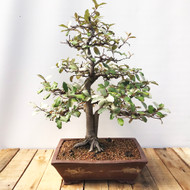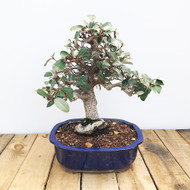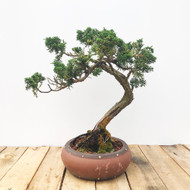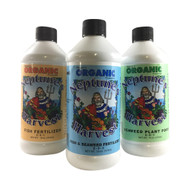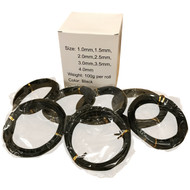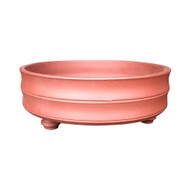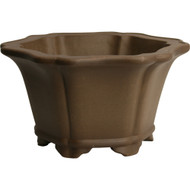General Information:
The Bahama Berry is native to the island of Inagua in the Bahamas. This tree has a very small shiny green leaf with close internodes. Bahama Berry likes it hot and, if grown indoors, will appreciate warm feet during winter (try a grow light.) The nature of the tree is to grow as a rangy shrub. The white fragrant flowers are tiny and form in clusters. Berries that follow are reddish orange. The leaves are also fragrant – herb-like. These trees can be trained in the shohin (small) and mame (miniature) style.
Location:
Bahama Berry do best with lots of light and high humidity. If you keep them inside, find a place that gets a ton of sun. If you want to keep it outside, it can tolerate just about any condition, but don’t let it freeze.
Watering:
Bonsai trees live in small pots and their world dries out much quicker than plants in the ground or in bigger pots, so close attention should be paid to watering. Keep your tree evenly moist. Striking a balance between not enough water and too much water can be a bit tricky but is very important. Water thoroughly and deeply when it needs water and let it catch its breath before watering again. An old bonsai watering trick is to place the entire pot in a sink of water an inch or two deep and let the water absorb from the holes in the bottom of the pot. Another favorite way to know if it needs watering is to lift it. You can get a sense for whether it needs watering by its weight.
An inexpensive moisture meter takes the guesswork out of watering. Water slowly so it absorbs into the dirt. Bahama Berry wants to be consistently moist and wet and never, never dry. Another name for the Bahama Berry is “I Dry-I Die” – unlike many tropicals that can be brought back from the brink of a dead wilt.
Misting:
Leaves want humidity to keep them green and healthy. Any time your tree is inside, the air is very dry. Mist often during the week. Avoid putting your bonsai near a draft or vent which dries out the foliage but do keep circulation flowing. A humidity tray is one way to increase humidity. These shallow trays can be filled with small stones and water. Make sure the water does not reach the bottom of the bonsai pot. As the water evaporates, it creates a moister environment.
Fertilizing:
Fertilizing a bonsai is essential to its health because the nutrients in the soil leave very quickly with the water. When new growth appears in the spring, it’s time to start feeding your bonsai. Use a balanced fertilizer with nitrogen once every two weeks during the growing season. In late summer when growth starts to slow, reduce the feeding to once a month. During the fall and winter months when your bonsai is in its “resting” or dormancy phase, use a no-nitrogen fertilizer. This will help the plant’s root system stay healthy and active without encouraging new foliage growth. A vitamin supplement/root stimulant is an excellent complement to fertilizers.
Pruning:
To develop the foliage, clip out the tender new shoots. The Bahama Berry is somewhat brittle, but it can be wired. Trim frequently to keep its shape once the initial trunk and branch shape is established. Clip-and-grow is the best way to develop and maintain your Bahama Berry.
Repotting:
Bahama Berry should be repotted in early summer, but not in late August. When repotting in early summer, the roots can be sawed off without attempting to comb them out. Repot young trees (up to 10 years) every other year. Repot older trees every 3-4 years. Repotting is necessary periodically to supply the plant with fresh soil. Prune roots moderately. After repotting, water thoroughly. DO NOT FERTILIZE FOR 3-4 WEEKS.
Wiring:
The Bahama Berry is usually trained via the clip and grow method. If you choose to wire, use the thinnest training wire that will hold the branch in the desired position. DO NOT WIRE A BONSAI JUST AFTER REPOTTING. Wind the training wire in the direction the branch is bent in order to keep the wire from loosening. Wrapping the wire too tightly will cause scarring. If you do use wire, wrap it loosely or use it only to tie down branches. Cut the wire carefully from the branch. DO NOT UNWIND WIRES. This could cause the branch to break.
Wiring must be watched carefully for signs of wire cutting into the bark. Wire must be removed immediately if this happens. If necessary, the tree can be re-wired after removing the old wire.
Insects and Diseases:
Bahama Berry are susceptible to mealy bugs underneath the bark. Mealy bugs may require a manual tweezer extraction to preserve the tree’s appearance.
Pit scale likes to infest the Bahama Berry. You can prevent scale problems by keeping your bonsai in a well ventilated area. Air circulation also encourages cell growth. Scale insects are tiny creatures with a scaly outer shell. These sap-sucking insects have white or grayish, waxy shells and are most vulnerable to insecticides early in the year before the newly hatched nymphs have developed their waxy protective coating. Scale insects encourage the spread of fungal disease problems which are more likely during the dreary, wet fall and winter days and into the soggy spring days too. Use a mild fungicide and keep the air flowing to chase away fungal problems.
You should inspect your tree several times a week to look for problems. Spraying your bonsais once every month or two with a non-toxic insect spray should keep the tree clean and healthy. Soaps should be rinsed off the next day. DO NOT SPRAY WHEN SOIL IS DRY.
DISCLAIMER: The content provided in this article is not warranted or guaranteed by Bonsai Outlet. The content provided is intended for entertainment and/or educational purposes in order to introduce to the reader key ideas, concepts, and/or product reviews. We are not liable for any negative consequences that may result from implementing any information covered in our articles or tutorials. Happy bonsai gardening.


